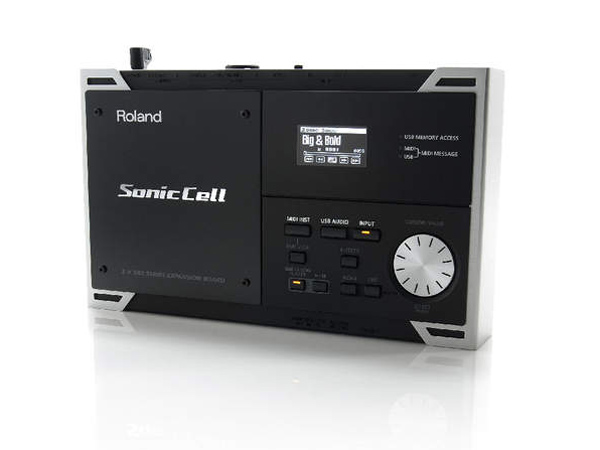MusicRadar Verdict
Sonic Cell does what it promises to do well but leaves you wanting just a little bit more.
Pros
- +
Good selection of sounds. Computer compatibility. Plays back multiple file types.
Cons
- -
Based on old technology. Badly designed volume control.
MusicRadar's got your back



Roland's General MIDI-based Sound Canvas modules have been popular since their inception almost 20 years ago. Sonic Cell is a sound module, audio interface and file player combined - a true Sound Canvas for the modern world.
Functionality is split into three main areas. For starters, there's a sound module with 128 sounds and scope to provide more via the SRX series of Roland expansion cards, of which there is room for two.
The majority of the sounds are emulations of 'real' instruments - pianos, strings, basses, percussion and the like. A General MIDI bank contains all the usual suspects and there are some synth patches, too.
Next we come to Sonic Cell's audio interfacing capabilities. A rear-mounted USB port enables you to connect directly to your computer and a quick install of the bundled driver software instantly transforms the unit into an audio hub.
You can record sounds directly through Sonic Cell to your Mac or PC and inputs are provided to cater for most needs. You've got stereo line in, an XLR input and a switchable Hi-Z input for guitar sources. A rocker switch is in place to confirm your input choice.
You can also record through the lush-sounding onboard effects processors, of which more shortly.
Lastly, you can use Sonic Cell as a playback module for a variety of audio and MIDI file formats. WAV, AIFF, MP3 and SMF file formats are supported and Sonic Cell lets you create playlists on the unit itself to organise playback.
A 'flat' USB connection at the rear lets you do this direct from a USB drive or memory stick, which is a really handy feature. Sonic Cell could, for example, provide a keyboard player with a full line up of sounds for a live show while also providing the pre-gig backing music.
In use
Rear-mounted MIDI ports let you connect directly to a MIDI interface or keyboard and you can be playing in no time. In classic Roland tradition, the architecture is of the Patch/Performance type - individual patches can be grouped into Performance sets of up to 16 instruments for multitimbral playback.
Dialling through sounds is achieved with the jog wheel, which can be pressed to confirm a selection. The 'real' sounds are reasonably authentic, while the synth patches - which run from warm leads to icy pads - are serviceable too.
The sounds are enhanced by Roland's truly wonderful effects processors, of which there are three. The basic Chorus and Reverb modules are joined by a powerful MultiFX unit, which contains 78 effect types.
These range from additional reverbs through flangers and phasers to distortion units. Rather than being there just to add a little spit and polish, they genuinely lift these sounds up to a higher place.
Elsewhere on the box itself, a toggle switch on the front shifts the sample rate if you're working with a computer. The options are 44.1, 48 and 96kHz; you'll need to match this setting to your DAW environment to avoid complications.
Next to this is a discrete volume control - a highly unusual small rotating dial buried into the side of the front panel. Sorry Roland, but we're not sure about this at all.
Summary
The Sonic Cell delivers what it promises with a minimum of fuss. If you need a sound module with a wide range of tones this is certainly fit for purpose.
There's little here that sets the pulse racing - and no killer feature that sets it apart from the competition - but Sonic Cell is reliable, covers its sound base well and comes with a software editor that enables you to build or tweak any sound to within an inch of its life.
It has to be said, though, that that this is much the same sound engine that's been propping up Roland synths since the late 80s. With more advanced technology available elsewhere in its product line, the Sonic Cell could have been exciting rather than merely dependable.
Here are three audio examples of Sonic Cell's sounds:
MusicRadar is the number 1 website for music makers of all kinds, be they guitarists, drummers, keyboard players, djs or producers...
GEAR: We help musicians find the best gear with top-ranking gear round-ups and high- quality, authoritative reviews by a wide team of highly experienced experts.
TIPS: We also provide tuition, from bite-sized tips to advanced work-outs and guidance from recognised musicians and stars.
STARS: We talk to musicians and stars about their creative processes, and the nuts and bolts of their gear and technique. We give fans an insight into the actual craft of music making that no other music website can.
“If you've got one follower or 10 million, that doesn't matter. What's really important is the quality of the music”: Dr Dubplate on the "gatekeeper mentality" in club culture
Who Wants To Live Forever?: The composer still creating music from beyond the grave
"The demo had my singing on it. When I played it to the band, the look on their faces said, 'We’re in trouble, boys'"










